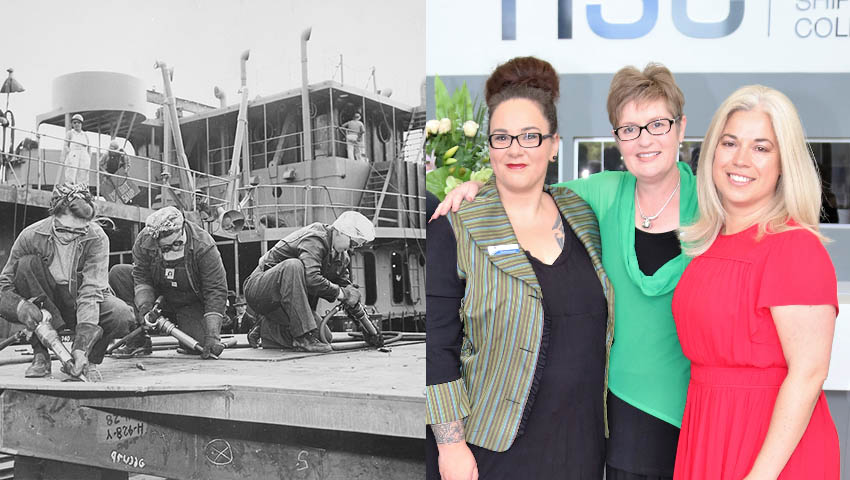With our brightest women continuing to excel in skilled and professional naval shipbuilding careers, industry has renewed its focus on securing the personal and professional qualities that Australian women bring to the workplace.
It’s true that life on a shipyard can be arduous, particularly when you’re manoeuvring through the confined spaces of a steel hull, buried deep in a computer aided design or managing the time pressures of delivering some of the world’s most technologically advanced projects. However, women in the naval shipbuilding industry say they wouldn’t have it any other way.
There are undoubtedly significant personal rewards on offer including a challenging, diverse and long career. In addition, many women have identified the substantial opportunities ahead to shape the naval shipbuilding environment and in doing so, to attract and benefit women for generations to come.
Widely recognised for their leadership and management abilities, promptness, meticulousness and commitment, hundreds of women are shedding outdated workforce stereotypes and donning their safety gear each morning to lead the largest peacetime modernisation of the Royal Australian Navy’s fleet.
Senior principal engineer (naval architect) at QinetiQ Violeta Gabrovska said she has always been interested in how things work, "I love to be able to create something or be part of the creation of something which will be used by thousands of people and however big or small, it will make a difference."
Across at Nova Systems, 21-year naval engineering veteran Lieutenant Commander (Ret'd) Lee Kormany, secured a maritime program manager role, which provided her with an opportunity to continue supporting the Australian Defence Force.
"It made that transition from uniform to civilian a 'soft landing'," she said.
Her colleague and graduate engineer Sherry Tang was also attracted to naval shipbuilding because of the range of professional development opportunities.
"There are many courses such as ship certification and naval weapons systems that you can complete to expand your knowledge and then use this within the naval shipbuilding industry."
As a mechanical engineer at Nova Systems, Sarah Cannard said the industry provided her flexibility after returning from maternity leave, "It offered the level of flexibility I required as a mother to three young children, whilst also supporting my professional development and career aspirations."
Despite the many success stories, our shipyards still don’t reflect Australia’s diverse and progressive communities; and more needs to be done to address the gender gap.
According to research prepared by consulting firm Rapid Context, women account for 28 per cent of professional positions and only 20 per cent of management positions across the top 20 defence contractors in Australia.
This lags behind general industry in which 49 per cent of management positions are filled by women. The report also highlights that in 2016 only 15.4 percent of applications for university engineering places came from women. A shortfall that clearly follows through into the workplace with women accounting for less than one in eight engineers in Australia’s labour force.
Despite the national shortage of skilled tradespeople, only small numbers of women are applying for apprenticeships in a traditional trade and few employers are taking them on. This trend is replicated across industry workforce numbers in the key naval shipbuilding hub of South Australia, where "only one in every 10 employees are women".
Equally as concerning is the report shows that only nine out of the top 20 defence contractors had specific gender pay equity targets to address the issue.
Naval Shipbuilding College communications and engagement manager Melody Earl said that more needs to be done to ensure that smart and skilled women seize the unprecedented range of job opportunities that exist in Australia’s rejuvenated naval shipbuilding enterprise.
"More than 15,000 skilled and professional naval shipbuilding jobs will be created to build and sustain the Royal Australian Navy’s future fleet, including the Attack Class submarines, Hunter Class frigates and Arafura Class Offshore Patrol Vessels," she said.
"With decades of naval shipbuilding and sustainment work in the pipeline, women have an opportunity to secure meaningful work over their lifetime, from the ship deck to the board room."
The Naval Shipbuilding College was established to develop a skilled and qualified sovereign workforce and its key priority is to ensure the pool of talent represents a diverse community, by elevating naval shipbuilding as a career of choice for the thousands of job-ready women across the nation.
The Australian government’s $90 billion commitment to a continuous naval shipbuilding enterprise presents a once in a generation nation building endeavour, however it isn’t the first time that Australian women have been on the industrial frontline.
In the 1940s, with the tides of war on Australia’s doorstep, traditional roles changed out of necessity and our shipyards were overflowing with women. Women entered the workforce in unprecedented numbers to build our warships to carry troops and support our allies on the war front.
Women were critical to filling a labour gap, working shifts as welders, crane operators, electricians and joiners, while the men were away at war. Women would work in the factories each day to make anything from bomb casings and parachutes through to welding metal plates.
Despite the challenges they faced during the 1940s, women were admired for their speed, precision and dedication, attributes which are broadly recognised across the workforce today.
There is now a renewed call to action for Australian women to join the defence industry and become an integral part of the national naval shipbuilding enterprise.
The Naval Shipbuilding College’s Melody Earl said it’s important that future employment opportunities within the industry are used to address that imbalance.
"It’s not just about bashing metal, although women do that very well, that’s just the structure of a ship, and it doesn’t include all of the roles required to build and maintain the smarts of the ship," she said.
"I want women to know that there is opportunity for them."



